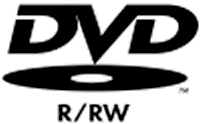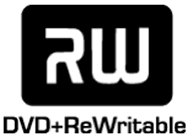DVD Media Format Compatibility Tests
2. Technical Background
Review Pages
Introduction
Brief History of DVD Formats
In 1997 Pioneer released the first DVD writer at an approximate street price of 35,000USD. This first DVD writer used DVD-R. This format was created by extrapolating the DVD-ROM standard in the same way CD recording came about from CD-ROM and CD-DA. This format was naturally termed DVD-R, the dash being used as the physical symbol connected two parts of an acronym. The DVD Forum has always supported this format.
 In 1999 the DVD Forum was established to promote a broad acceptance of DVD products on a worldwide basis, including the entertainment, consumer electronics and IT industries as well as to the general public. The DVD forum is a voluntary association of hardware manufacturers, software firms and other users of the digital versatile disc (DVD) formats.
In 1999 the DVD Forum was established to promote a broad acceptance of DVD products on a worldwide basis, including the entertainment, consumer electronics and IT industries as well as to the general public. The DVD forum is a voluntary association of hardware manufacturers, software firms and other users of the digital versatile disc (DVD) formats.
 Since then developments within the area of DVD writing/recording have been rapid. Today you can buy a DVD writer for less than $300! As the number of manufacturers entering this market increases, so does the number of options to the consumer. Once there was only one medium to choose from, DVD-R, then came DVD-RW and lately both +R and +RW disc formats appeared, along with a bunch of new writers supporting them as well. As the number of media manufacturers increase, the cost falls.
Since then developments within the area of DVD writing/recording have been rapid. Today you can buy a DVD writer for less than $300! As the number of manufacturers entering this market increases, so does the number of options to the consumer. Once there was only one medium to choose from, DVD-R, then came DVD-RW and lately both +R and +RW disc formats appeared, along with a bunch of new writers supporting them as well. As the number of media manufacturers increase, the cost falls.
Philips proposed a different format to be used. This new format was named +RW which was released during the autumn/winter of 2001 with the +R format being released later. I remember reading marketing material to the press claiming 100,000 cycles re-writability endurance. But when finally the first +R/RW writer hit the market we soon learned that these new formats were clever ways to differentiate the market position of the companies involved and collect royalties from the other manufacturers.
Market reaction and media availability
 The major components of a DVD writer or recorder are being manufactured by only a handful of companies. There are currently available DVD-R/RW only drives from Pioneer and Toshiba, +R/RW only drives from Philips and Ricoh, while Sanyo, NEC and Sony offer dual format drives. Pioneer has recently announced their new dual drive (DVR-A06). Most manufacturers buy and use components from these large manufacturers. So it seems there is a tendency for the introduction of writers supporting both formats and certainly the clear majority supports at least the DVD-R/RW format. However the end user's concern is most likely not only which drive to buy, but which type of media to use as well!
The major components of a DVD writer or recorder are being manufactured by only a handful of companies. There are currently available DVD-R/RW only drives from Pioneer and Toshiba, +R/RW only drives from Philips and Ricoh, while Sanyo, NEC and Sony offer dual format drives. Pioneer has recently announced their new dual drive (DVR-A06). Most manufacturers buy and use components from these large manufacturers. So it seems there is a tendency for the introduction of writers supporting both formats and certainly the clear majority supports at least the DVD-R/RW format. However the end user's concern is most likely not only which drive to buy, but which type of media to use as well!
4x speed DVD-R media is somewhat cheaper than comparable speed +R ones. Some sources within the industry claim DVD-R�s lower media price is due to the fact that there have been more DVD writers sold supporting the DVD-R only format than those using only the +R format. Although there is greater demand for DVD-R media, it is somewhat easier to find +R discs. The +RW alliance claims that this is due to more manufacturers making +R/RW media. We personally believe that the somewhat wider availability of +R/RW media is due to the better distribution channels followed by Philips. In any case it is easy to find cheap media of both formats, but DVD -R media is somewhat cheaper.

Media formats compatibility and the CdrInfo.com tests
As far as the consumer is concerned there are a number of factors that will influence his or her decisions when deciding which type of media to use. Prominent criteria will be the backward compatibility with respect to their other players and PC drives. We are addressing this issue within our current review. We have tested over a thousand of recorder/player/media combinations to find out which format is the most suitable to use right now: DVD-R/RW or +R/RW? To view this result click here.
If you are interested on some technical issues concerning DVD and the two rival formats you may read the next section. Otherwise, you can go straight to the third section were we start explaining our motivations for choosing the players, recorders and media tested and our methodology on doing the tests. These parameters will influence the test results and we explain in some detail what particular "measure" of compatibility we use for the assessment and presentation of our tests. We even explain the way we did a lot of computational analysis in order to finalize the numbers we will present here.
We certainly feel that different player choices would certainly lead to somewhat different compatibility results. We know that different players share different portions of the market. If we had decided to weight this in our programming analysis, we would certainly arrive at even more favorable results for DVD-R.
For example Panasonic players seem to suffer from a particular genetic "disease" which forces them to misbehave on +R/RW discs. Since Panasonic has a high market share, if we weighted our findings based on this fact we would have certainly obtained even better compatibility results concerning the DVD-R/RW formats. Anyway, since it was difficult to get an accurate indication of market share for each particular model we decided not to further exploit this possibility.
We hope you will find our next exposition both interesting and rewarding. Please read on ...
Review Pages













